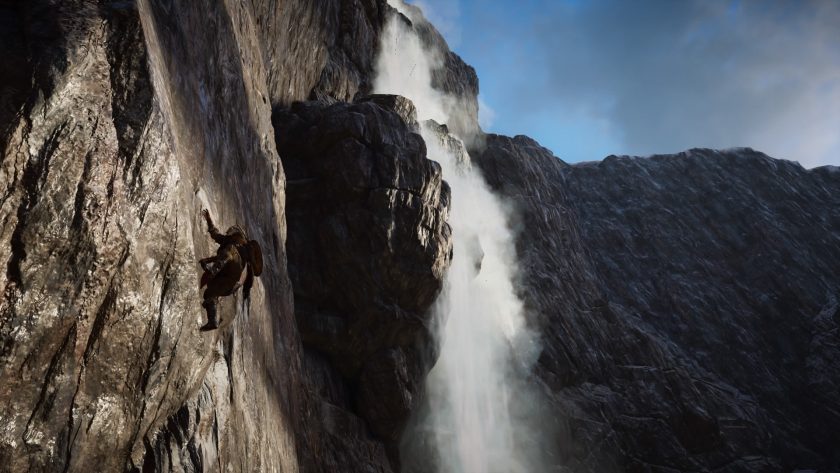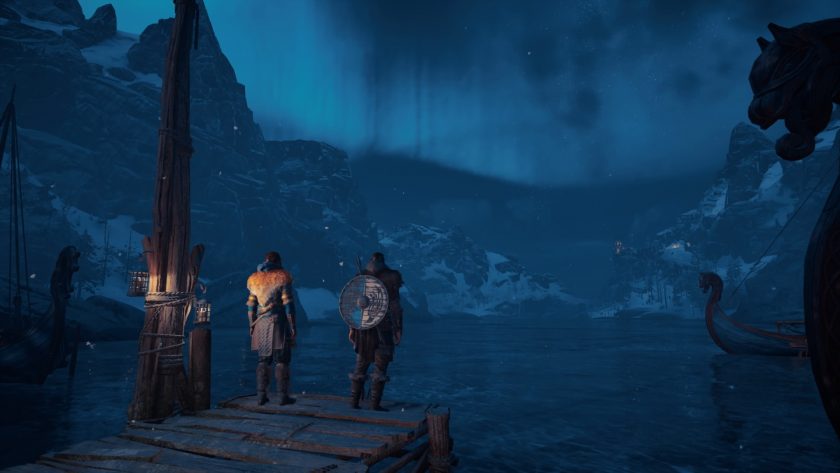
As much as I enjoyed playing Assassin’s Creed Odyssey, I felt that the series had strayed too far from its origins with the new RPG mechanics introduced in Origins(see what I did there?). The series was getting stale, no doubt, and the new approach brought a much-needed breath of fresh air but Odyssey was a bit too much to chew, with a very tiresome grind and an overwhelming amount of things to do. Assassin’s Creed II remained my favorite entry into the series, closely followed by Black Flag.
AT A GLANCE
Release Date: 10 November 2020
Developer: Ubisoft Montreal
Publisher: Ubisoft
Platforms: PlayStation 5, Xbox Series X and Series S, PlayStation 4(Reviewed), Xbox One, Google Stadia, PC
Final Score: 9/10
With the arrival of Assassin’s Creed Valhalla, the latest entry in the long-running franchise, it has become without a doubt my favorite Assassin’s Creed game yet.
Story
Assassin’s Creed Valhalla takes us back to the 9th century AD where you control Eivor, a Viking within the Raven Clan in Norway. One thing leads to another and Eivor along with us adopted brother Sigurd set sail for England where they set up their own base called Ravensthorpe.
Thus begins a story where Eivor and Sigurd must forge alliances, fight enemies and carve out a piece of England for themselves. While most of the main missions are still generic tasks that require you to stake out an enemy fortress or follow someone, it’s the sidequests that took the cake for me. Each of these sidequests felt organic, and had a wide variety to them, bringing the world around Eivor to life.
You are free to chose between a male or female Eivor, or let the animus choose it for you. While this might sound weird, there’s an in game explanation for all this and the lack of any difference when playing as any of these genders means that you are not punished for your choice.
The story itself is very compelling and has plenty of twists and turns, something that I felt was missing from the newer entries in the franchise. What surprised me even more was the impact that my choices had, sometimes affecting the story in subtle ways that I wouldn’t have figured out if I didn’t go for a second playthrough of the story.
There’s a lot of mythical elements used in the story, as one might expect from a game titled Valhalla – the hall where Odin hosts the brave Norse warriors who died in battle. None of these elements however felt too over the top and out of theme with the story, but for those willing to dive deeper into the lore and explore the world, there’s quite a lot of juicy tidbits to pick apart.

Meanwhile in the present, you still play as Layla. Layla’s character growth has been significant over the past few games, and while I am still a bit grumpy they killed off our boy Miles so unceremoniously, Layla has so far been a very convincing protagonist. The emails and various documents that are available for the player to read from the menu allow a look into her life, and an interesting read for those wanting to delve more into the modern timeline, without being intrusive. In fact, I think Ubisoft has finally managed to balance both the Animus sequences as well as the ancestor memory sequences, giving players the freedom to jump around whenever they want and taking away as little control as possible.
Ubisoft has done a great job of fleshing out the characters and making them have depth. Since your homebase of Ravensthorpe is vital in order to unlock various new equipment as well as upgrade your existing arsenal, you will be constantly dropping by here. Each of the characters in Ravensthorpe go about their business and your interaction with them helps in developing bonds that were simply not present in terms of side characters in previous games.
Overall, Valhalla’s story felt more cohesive and well structured than any of the recent entries into the franchise. Coupled with a strong cast of characters and a more focused, player-driven narrative, Assassin’s Creed Valhalla has a compelling story that manages to remain strong from start to finish.
Gameplay
Assassin’s Creed Valhalla continues using the same template that was introduced in Origins. It still has the RPG mechanics and features a huge open-world for you to explore on foot, horseback, or sea. However, Valhalla overhauls a lot of these mechanics to deliver a more complex and polished experience, while bringing back a few key mechanics from the older games.
Starting off with the combat, it’s still a combo heavy combat system with a focus on exploiting enemy attack patterns. Skills return as well, but this time they must be discovered by exploring the world and finding tomes. Weapons choice is hugely expanded upon, and now allows you to basically dual wield almost any one handed weapon. This means you can equip the standard shield axe, two axes, two swords and even two shields. While combat doesn’t vary radically between some choices, there is still a significant change in the experience. So if you find things getting too stale, you can switch around. Ranged also returns of course, and you can still coat your arrows with various elements to augment your combat prowess. The hidden blade also returns, and this time it’s a proper hidden blade, allowing you to execute the series’s trademark stealth assassinations, although most of the time you will have to resort to combat in higher leveled areas.
Enemies also vary quiet a lot, from brigands to temple guards and the odd wild life. While there is still a requirement to grind before you can approach the activities in the higher level areas, the grind is very minimal when compared to Odyssey, and because of the wide variety of weapons that you can use, it’s very much possible to tackle higher level areas while being underleveled if you are comfortable with your current combat style.

One of the biggest additions to the game is raiding, which allows you to raid various monasteries, temples and outposts with your viking army. On approaching these eligible areas, you can blow your war horn and your raiding party will rush in to attack. I absolutely loved these raids, and I was pleasantly surprised at how great the AI was at handling itself. Not only did the enemies offer me a very enjoyable challenge, but my own raiders held up quite well, even helping me out once or twice out of a tight spot. Raiding rewards you with resources that are essential to upgrading your base, as well as giving you new weapons, armor or skills.
Almost all activities reward you with XP, and this can be used to unlock new skills, enhance your combat prowess as well as unlock various bonuses to armors sets.
Once again surveying for items is done with the help of your bird, this time, a raven names Synin. Synin scouts ahead for you, revealing resources, chests, nearby enemies, and points of entry into strongholds. However, instead of being an UAV capable of detecting enemies behind walls like the birds in previous games, Synin does not mark these enemies automatically. You may place a marker on any interesting points you find, and then using your Odin Sight(Eagle sight), you must find out enemies, as well as nearby unclaimed chests. This means that you will have to explore in order to find different items, and combined with a few options that disable automatic quest marking and minimal UI, completely transforms the way you approach the game.

Stealth returns from the previous game and has been heavily overhauled, bringing back the ability to blend into crowds as well as the cloak. Because Eivor is outlawed from a lot of places due to him being a bloody viking, it is important to remain low profile. Eivor can do this by wearing his cloak, which reduces the field of vision for guards and can help him to quickly become incognito. Combined with the hidden blade, and most levels having a plethora of hiding spots, it is very much viable to stealth your way through certain areas.
Ravensthorpe is an integral part of Eivor’s journey, both in terms of the narrative as well as the gameplay. Raventhorpe acts as the hub for upgrading your weapons, unlocking new facilities as well as undertaking key missions to forge new alliances. Because it is so vital, and you are able to customize Ravensthorpe to your liking, you end up building a bond with Ravensthorpe. It’s more than just a generic hub, but if you aren’t into grinding for resources and growing your settlement, that’s fine as well. Although I highly suggest that you do.
There’s no shortage of things to do in Valhalla, with a huge number of side quests, raiding, pillaging, spelunking, a main story that’s 20-25 hours on it’s own and some decently enjoyable minigames. Flyting is one of those mini-games I really enjoyed, it’s a form of rap that apparently all the hip Vikings are into. Ubisoft has really done a tremendous job at packing the game with content while preserving the quality as much as possible.
Visuals, Audio and Technical Performance
Visuals have always been Assassin’s Creed’s strength. Even the oldest games in the franchise pushed the technical capabilities of their time, with some of the newer entries bringing the current gen console to their knees. Valhalla is no different, and in fact it improves in terms of the overall visual direction in every way possible.

The world-building in Valhalla is phenomenal, with different biomes and a wide visual variety to the map. From snowy mountains to lush grasslands to densely packed cities, the world of Valhalla constantly offers you something new to see.
The water in Valhalla deserves a special mention, because it is quite frankly some of the best water I have ever seen in video games. It looks phenomenal, and because of the amount of time you will be spending in water, traversing and raiding, I am glad I don’t have to watch at ugly water textures.
Not everything is picture perfect though, because while the faces of the characters looks well modeled, lip syncing still leaves a lot to be desired. There’s also a lot of weird collision bugs that were also present in the previous games, and I really hoped would be ironed out of the engine by now.

In terms of audio, the OST is really well done and sets the mood for whatever activity you are doing. Adrenaline pumping orchestral music starts playing when raiding, soothing music beckons for adventure when you are out riding and low subtle music plays when you are in stealth.
The background noises and overall voice acting is also well done, but some performances did feel a little bit overzealous than the rest.
In terms of technical performance, aside from the occasional bugs, I am honestly surprised at how well it runs on the base PS4. I faced almost no dips, and no fatal crashes. Loading also seems to somehow have improved, because in Odyssey I remember whenever Ikaros strayed too far for me, the game would do a small loading but this is very minimal in Valhalla.






